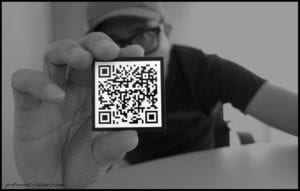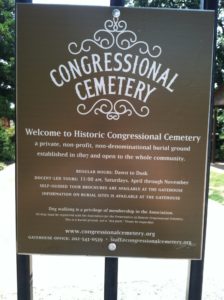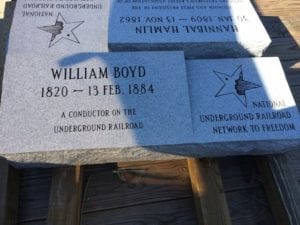QR Codes Bring Black History to Life at DC’s Congressional Cemetery
By Potomac Photonics
Category: 3D Printing, Articles, Company, Industry

Laser Marked QR Codes help a headstone company bring black history to life for a Washington, D.C. cemetery.
In recent years, Potomac has done some rather interesting laser coding and marking work for customers. With the current celebration of black history month, we’d like to share one such project using QR Codes to help a headstone company bring black history to life for a Washington, D.C. cemetery.
Congressional Cemetery is an historic resting place for many figures associated with American history. Previously known as the Washington Parish Burial Ground, it was a logical extension that the Capitol Hill location would encourage Congress to purchase sites and build monuments to Congressmen who had died in office. Around 1830 everyone started to simply refer to it as Congressional Burying Ground, later Congressional Cemetery, and the name stuck. It is a private non-profit organization and has no government affiliation, but Congressional Cemetery is still an important link to the people who have been in the U.S. government, as well as the ordinary citizens who played a part in our nation’s history.

Congressional Cemetery is an historic resting place for many figures associated with American history.
Wanting to tell the story of the men and women interred on their grounds, Congressional Cemetery turned to Rusty Sams, the owner of Oakview memorials in neighboring Waldolf, MD. Rusty knew that it would be a great time to bring some 21st century tools to the cemetery’s historic perspective. He suggested using QR Codes on the headstones of the historical figures that would link to website pages about the person’s story.
The cemetery chose to begin with four people who were instrumental in the Underground Railroad, a network of secret routes and safe houses used to help slaves escape to the North. The term is also is applied to both black and white abolitionists who aided in bringing these human beings to freedom. One of the black freedom champions didn’t even have a headstone. In addition to building new tombstones for Congressional Cemetery, Rusty worked on adding a QR Code that would tell the details of the individual’s contribution.
“I added 1.25” x 1.25” square plaques to the headstones,” explains Rusty, “but needed a process that would withstand the elements.” Metal plaques fit the bill but he needed a marking process that worked on metal. “It was hard to find a supplier who could make the plaques,” says Rusty. I called perhaps 30 vendors in the DC area and most didn’t know what I meant by QR Codes.”
Potomac President and CEO Mike Adelstein explains that laser engraving QR Codes is not an easy process. “We’ve worked for years, not just to be able to create precise marks. Potomac also had to configure the interface with the QR Code readers on smartphones since platforms vary and it is not standardized. With more and more application for QR Codes, we refined the entire process to better serve our coding and marking customers.”

Congressional Cemetery is an historic resting place for many figures associated with American history.
Potomac can put QR Codes on virtually any surface including glass, plastics, and metals such as anodized aluminum or stainless steel. The laser marks are great for QR Codes since without burning or charring they are crisp and clean enough to be read by the smartphone readers.
“The tags were exactly what I was looking for,” says Rusty. “In addition to having a good technical solution, Potomac listened and I had the best customer experience. They took the same steps I take in my business, working to get the best end result for our customers.”
Rusty is looking forward to Congressional Cemetery recognizing more historic figures in the future. But in the meantime, Potomac is pleased to be a part of keeping the Underground Railroad story alive in celebration of Black History Month.





